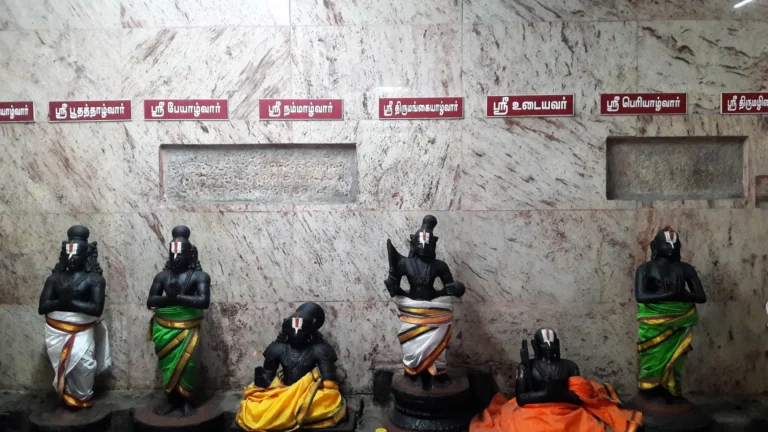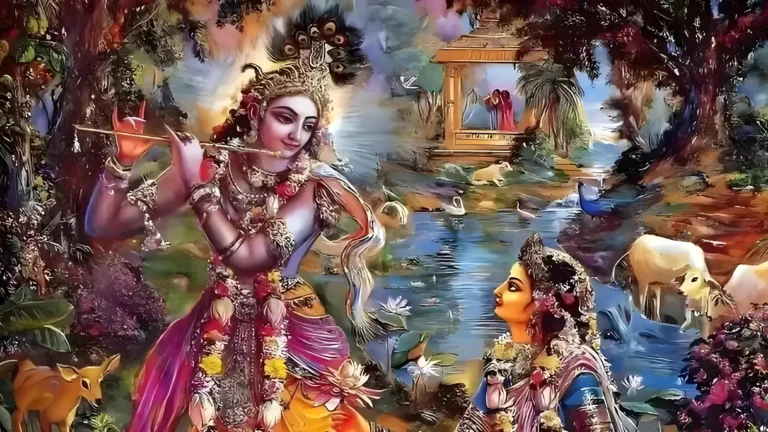Please Like the Blog and Share it for Maximum Reach
Table of Contents
9 Vedic Truths as Revealed by Vaisampayana in the Harivamsa
- Brahman, Pradhana, Purusha explained
- Yogic spontaneous creation stages
- Manifestation of Avyakta, Mahat, Ahamkara
- Understanding of Sarga and Visarga
- Divine link between Vedas and Narayana
- Explanation of Manu and Shatarupa’s role
- Evolution of reproduction through duality
- Revelation of Vedantic Truths in Harivamsa
- Cosmic significance of the Trayī Vidyā
In this blog article, we shall discuss the Harivamsa Purana’s introductory characters and its main subject matter.
Who is Sauti?
Sauti, popularly known as Ugrashravas Sauti, or Suta Goswami is the revered Narrator of the Mahabharata and other Sacred Puranas. Across various Vedic Scriptures he is depicted imparting the divine knowledge to the assembly of sages led by Sri Sounaka, in the forest of Naimisha.
Before commencing the divine recitation of the Harivamsa (which is an extension of the Mahabharatha), Sauti offers humble salutations to Lord Ganesha, Sri Vyasadev, Sri Nara-Narayana, and Devi Saraswati.
Glories of Harivamsa Purana
The glories of listening to the Harivamsa Purana are countless. It is equivalent to performing yajnas like Rajasuya and Ashwamedha. It purifies Karma as the light of knowledge (Jnana) guides us through what should be done and avoided, thus ensuring that we never stray from Dharma.
Sage Saunaka Puts Forward a Request to Sauti
The heroic deeds of the Kurus, as elucidated in the Mahabharatha, were absorbed with earnestness by the sages led by Saunaka. However, the epic very briefly highlighted the genealogy of Lord Krishna, the scion of the Vrishnis.
The naratees were now desirous to hear the sacred origin of the Vrishnis and Andhakas, which led Sauti to initiate the divine recitation of the Harivamsa, which is an appendix to the Mahabharatha.
The request of the sage reflects a deep spiritual insight. The Mahabharatha is a repository of Vedic wisdom, a handbook of Dharma, Karma, and Jnana. It guides and teaches man to uphold Dharma even in times of adversity, exemplified by characters like Sri Bhishma, Vidura, Yuddhishtira, Kunti, and Draupadi.
It details the meritorious deeds, trials, and tribulations of various kings (primarily the Kurus), inspiring us to stay surefooted on the path of Dharma. It has a wide range of intellectual discourses to put our minds to good use in deciphering the esoteric teachings of the Srimad Bhagavad Gita, the crest jewel of all knowledge.
It also contains the Yaksha Prashna, which answers complex questions about life in pointers. While the variagatedness housed in this epic lies beyond the scope of imagination, its pivotal theme remains individual will power and knowledge (Path of Karma and Jnana), thereby hinting vaguely at the dominance of divine grace which can only be felt through Bhakti and Sharanagati.
There are instances where the merciful nature of Sri Krishna is brought to light. However, the common man fails to understand it unless emphatically expressed. Thus, the Harivamsam fills in that gap and becomes indispensable in understanding the divine grace of Lord Krishna.
Sage Vaishampayana Begins the Narration to Janamejaya
Sage Vaishmapayana is the direct disciple of Sage Veda Vyasa and is known as the proponent of the Krishna Yajur Veda. He is featured in many scriptures in a conversation with Janamejaya, son of Parikshit, great-grandson of Arjuna.
When requested thus, Sauti recounts how Sage Vaishampayana had earlier narrated the lineage of the Vrishnis to Janamejaya, who had delivered the same.
Vaishampayana Narrates the Primeval Creation
Sage Vaishampayana lays the foundation of this great scripture by first revealing Vedic cosmology (an indispensable segment of any Purana). The description is one of the most esoteric parts of the Harivamsha.
Sage Vaishampayana explains that this tangible material universe emerges and is sustained through the same Principle known as Brahman (by the Vedantins), Pradhana (by Samkhya Philosophers), and Purusha or Bhagawan (by Bhaktas). Thus, the universe is born from Him, known by several names the unmanifest source of all.
Ishvara fills every atom, every breath, every being. He is not just the creator. He is within His creation, like light pervading space.
The process of creation is unique and described in different perspectives from scripture to scripture and from one school of philosophy to another. The classifications and descriptions vary due to different points of focus. Some may seem similar yet different due to a change in the cosmic cycles of Kalpas.
From Avyakta or the unmanifested (Maya), (the inseparable potency of Bhagawan), the Mahat Tattva comes out first. From Mahat proceeds Ahamkara. Scriptures classify Ahamkara into Sattvik, Rajasik, and Tamasik.
From Sattvik Ahamkara comes the mind, senses of knowledge, and senses of action. From the Tamasik Ahamkara rise Tanmatras and from the Panchabhootas. Then the whole external universe is created out of the five gross elements. By them are produced the four main classes arise. They are:
- Viviparous born from the womb like man and other animals
- Oviparous, or born of the egg as birds, fish, and serpents
- Sweat/Heat Born These are species born by heat and damp, as insects and worms;
- Those springing from the earth, as vegetables, trees
Today, science does not advocate spontaneous generation as there is a heightened dependence and interaction with matter. However, in the beginning, creation operated under different subtle laws that wholly emerged from yogic power (Tapas) and primal elements.
However, as the process of creation diversified, through the various methodologies introduced by Prajaptis, the process of life became mechanical and matter-dependent which translated into biological reproduction, which even science advocates.
These are created by Bhagawan so that the Vyasti creation can be carried out by Sri Brahma.
Appearance of Lord Brahma
There are various accounts of Lord Brahma’s appearance. Again, each episode maps to a different cosmic cycle. Following is a glimpse into the appearance of Lord Brhama, according to Harivamsam.
The Supreme Being manifested waters (known as Nārā in Sanskrit) and sowed seeds to commence the creation of the universe. He rested upon it and is, therefore, also known as Narayana.
The colossal egg known as Hiranyagarbha evolved from the seeds. It turned golden, and from there arose Brahma, the self-born creator. After a lapse of many years, Sri Brahma divided the cosmic egg into heaven and earth, bringing space (akasa), time (kala), and direction into existence.
Now one may wonder that Lord Narayana had already created space (Akasha) before the appearance of Lord Brahma. So, in the flow of creation, the subtle elements — ether, air, fire, water, and earth — were established in seed form even before Brahmā awakened.
Yet it was Brahmā, the first-born from the Golden Egg, who gave cosmic order. He revealed space by lifting the heavens and setting the earth afloat upon the waters. He marked the ten directions, thus adding form and space in creation, which had been hidden before. This implies that latent creation moved into active manifestation through Sri Brahma.
Mind-Born Sons of Lord Brahma
To pursue his duties and expand creation, Lord Brahma, out of the power of His purified mind, gave rise to the Sanat Kumaras. However, the 4 Kumara brothers refused to assist their father in the creation process, which meant engagement with worldly activities. They devoted themselves to Sri Narayana Bhakti and remained eternally young and celibate.
Another spiritual reason behind their disinclination towards materialistic living is the state of mind of Sri Brahma, at the beginning of creation. Lord Brahma meditated and purified his mind.
As an outcome, the Sanat Kumaras emerged, embodying His spiritual vibrance, unsullied and disinclined towards any materialistic activities. However, as the spiritual energy got expended, the mode of Rajas dawned, propelling Lord Brahma to deploy his duties as the creator of the material universe.
Thus, Lord Brahma created the saptarishis (seven mind-born sons), of great virtues and piety, who became successors of his will. They engaged in multiplying the mortal universe as well as propagated Dharma.
Appearance of Lord Rudra and Other Divinities
According to the Harivamsam, the Sapta Rishis are Marichi, Atri, Angiras, Pulastya, Pulaha, Kratu, and Vashishtha. Thereafter, Sri Rudra emerged from Lord Brahma’s anger, who also aided in the creation process. The family tree of the 7 mind-born sons consisted of Celestials, Asuras, Yakshas, Pishachas, etc., who performed dignified and pious deeds.
For example, Yaksha Kubera was the scion of Sage Vishrava, who was the descendant of one of the Sapta Rishis- Pulastya. Similarly, Asuras were sons of Sage Kashyapa who sprang from the loins of the Great Sage Marichi. Thus, many classes of living organisms came into being.
Alongside lightning, rainbows, rain, etc, were also created. To maintain sanctity in the cosmic creation, yajnas were introduced. For this purpose, Sri Brahmā created the sacred Vedas and their chants — Rig, Yajur, and Sāma — specifically to initiate and empower sacred Yajna rituals.
These three are collectively known as the Trayī Vidyā (त्रयी विद्या) — the Triple Knowledge of the Vedas.
Understanding the Revelation of the Vedas
Vedas are eternally existent. They cannot be created but only revealed. Vedaḥ Nārāyaṇaḥ sākṣāt
This means that the Vedas are Lord Narayana Himself. Lord Narayana is ananta, beginningless, timeless, and ageless.
Furthermore, at the beginning of each creation, divine will ordains Sri Brahma to reveal the timeless Vedas into active remembrance, so that other beings can walk the path of Dharma. A deeper and profound truth is revealed in
Bhagawad Gita-15.15
वेदैश् च सर्वैर् अहम् एव वेद्यः
vedaiś ca sarvair aham eva vedyaḥ
By all the Vedas, I alone am to be known.
Therefore, the sole purpose of the Vedas is to know Bhagawan.
To further make it explicable to mortals of this universe, an empowered being- Sri Veda Vyasa appears in every Dvapara Yuga to organize and transmit these truths, to benefit the world.
Sarga and Visarga Creation
Thereafter, from his mouth emerged the Gods, the ancestral manes from his breast, and from his hips the Asuras, Sādhyas and other classes of gods.
In the Vedic scriptures, the process of creation is not linear. The description of creation unfolds at various levels. At the macrocosmic level, there is Sriman Narayana, who gave rise to Sri Brahma, who was in turn at the helm of expanding the Universe.
This created a second layer of creation at the cosmic level. Lord Brahma gave rise to Prajapatis or the masters of various classes of living beings, where the Saptarishis hold a prominent position. In the cosmic creation (Sarga Stage), Lord Brahma creates the blueprint of creation, or rather, he commences the generic creation of human types (including other entities like asuras, devas, etc) or seeds, forming a prototype of humanity.
Lord Brahma classifies creation and brings forth various categories of species with predominant characteristics. However, the blueprint is translated to reality through the Prajapatis.
In the case of Human Beings, Manu and Shatarupa are deemed the progenitors of Mankind. Not only did they create Human beings (Visarga Stage), but they also brought structure to them through family, lineage, and varna, by decreeing Dharmic laws to preserve humanity. The civility and conduct that an ideal human being should possess are led by an example through this divine couple.
Therefore, Brahma, the divine creator, initiates the archetypes of all beings, including humans. But it is Manu and Shatarupa, who divinely created and joined in union, who become the first social humans — the parents of civilization, dharma, and lineage. Brahma creates life. Manu organizes it.
The Building Stages of Creation
The stages of creation according to the Puranas are fascinating. It began with Yogic power and then gradually shifting to elemental creation, finally culminating into procreation through union of male and female. Let us understand this-
| Category | Examples | Creation Type |
| Viviparous (Jarāyuja) | Humans, animals (born from wombs) | Sexual |
| Oviparous (Andaja) | Birds, reptiles, and fish (born from eggs) | Sexual |
| Sweat-born (Svedaja) | Insects, bacteria (moisture-born) | Semi-spontaneous |
| Earth-born (Udbhijja) | Trees, plants, herbs, creepers | Elemental spontaneous creation from Earth |
The first beings — rishis, devas, and pitris — were created purely by yogic will and mental projection.

Yet they were few and did not multiply naturally. Rishis were powerful and limited. But, they were required to expend their Yogic Power to create progeny, which was not an effective approach to sustain creation. Therefore, to populate the world fully, elemental creation began. Elemental creations refer to the beings that arise from the basic elements (pañcha mahābhūtas) — space (ākāśa), air (vāyu), fire (agni), water (āpaḥ), and earth (pṛthvī).
Rivers, trees, mountains, etc, were created.
In the earliest stages, trees, plants, and herbs grew by the interaction of Earth (Bhoota) and Gandha (Tanmatra). They were thus classified as Udbhijja. They were spontaneous gifts that sprang from the lap of Earth. However, these creations lacked conscious, self-driven efforts to multiply.
Higher mobile life-forms needed dynamic reproduction.
Role of Sage Vashishta in Creation
Eventually, Sage Vasishtha divided himself into male and female to highlight the necessity of duality for creation. It reinforces that the interplay of Purusha and Prakriti was the only sustainable option to keep creation thriving.
The path of natural multiplication began, culminating in the creation of Manu and Shatarupa. Lord Vishnu manifests in the form of Virata Purusha and creates Manu, the progenitor of the human race, whose time period or reign is known as Manvantaras.
Please Like the Blog and Share it for Maximum Reach

















